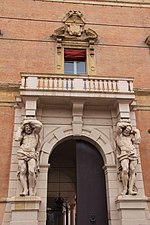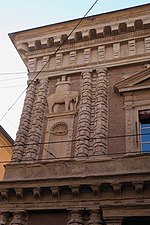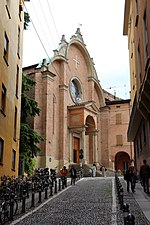Santa Maria dei Servi, Bologna
14th-century Roman Catholic church buildings in ItalyBasilica churches in BolognaGothic architecture in Emilia-RomagnaPages containing links to subscription-only content

Santa Maria dei Servi is a Roman Catholic basilica in Bologna, Italy. It was founded in 1346, as the church of the Servite Community of the Blessed Virgin Mary and was designed by Andrea da Faenza, a head friar and architect who also assisted Antonio di Vincenzo on the monumental Basilica of San Petronio. In the 20th century, Pope Pius XII granted the church the status of "basilica".
Excerpt from the Wikipedia article Santa Maria dei Servi, Bologna (License: CC BY-SA 3.0, Authors, Images).Santa Maria dei Servi, Bologna
Piazzetta dei servi di Maria, Bologna Galvani
Geographical coordinates (GPS) Address External links Nearby Places Show on map
Geographical coordinates (GPS)
| Latitude | Longitude |
|---|---|
| N 44.4917 ° | E 11.3526 ° |
Address
Santa Maria dei Servi
Piazzetta dei servi di Maria
40125 Bologna, Galvani
Emilia-Romagna, Italy
Open on Google Maps








